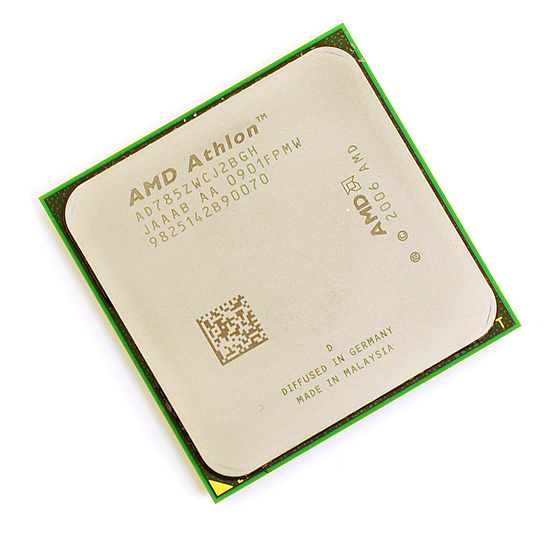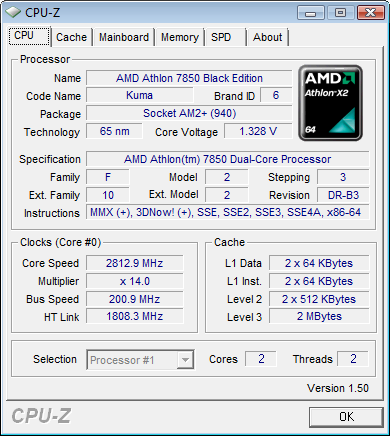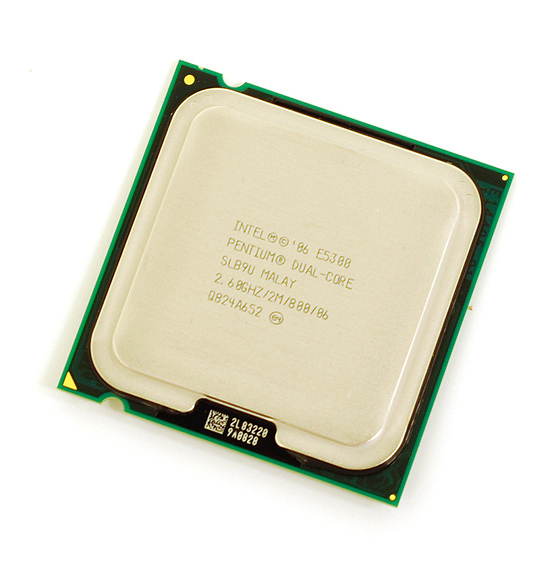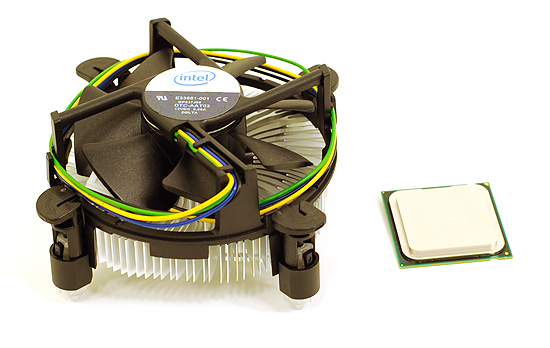AMD Athlon X2 7850 vs. Intel Pentium E5300: Choosing the Best $70 CPU
by Anand Lal Shimpi on April 28, 2009 11:00 AM EST- Posted in
- CPUs
AMD celebrates its 40 year anniversary next month, and the Athlon brand turns ten shortly thereafter. What better way to celebrate than by releasing a rebadged 65nm Phenom processor with two cores disabled at $69? Er, or, I guess they could’ve sent a cake.
It’s called the Athlon X2 7850 and it actually has very little in common with the old Athlon 64 X2s. As I mentioned, these are rebadged 65nm Phenom processors with two cores disabled. The table below should give you a good comparison between the die size and transistor count of the original Phenom compared to the new Athlon X2:
| Processor | Manufacturing Process | Die Size | Transistor Count |
| AMD Phenom X4 9950 | 65nm | 285 mm2 | 450M |
| AMD Athlon X2 7850 | 65nm | 285 mm2 | 450M |
There’s no surprise that the specs are identical, because the processors are identical. AMD simply disables two of the Phenom’s four cores in production before shipping the parts.
In its heyday the original Phenom never broke 2.6GHz, but with a fully mature 65nm process and only two functional cores AMD is able to clock these parts higher. The first dual-core Phenom derivative was the Athlon X2 7750 and it ran at 2.7GHz. In AMD’s tradition of introducing far too many CPUs, today AMD expands the list with a 2.8GHz Athlon X2 7850.

Once again this is the original Phenom processor; none of the advancements found in the Phenom II are included - it also means that the architecture doesn’t make quite as much sense.

It's a Socket-AM2+ Processor
The original Phenom architecture was designed to be used for quad-core processor designs, hence the use of a large shared L3 cache alongside private L2 caches. With only two cores, many of the benefits of this architecture are lost. Intel discovered that the ideal dual-core architecture featured two levels of cache with a large, fast, L2 shared by both cores. AMD and Intel came to the conclusion that the ideal quad-core architecture had private L2 caches (one per core) with a large, shared L3 cache. The Athlon X2 7850 takes the cache hierarchy of the ideal quad-core design and uses it on a dual-core processor.

To make matters worse, it does so with an incredibly small L3. Intel found that on its Nehalem processor each core needed a minimum of 2MB of L3 cache for optimal performance. With Phenom II AMD settled on 1.5MB L3 per core. The original Phenom gave each core 512KB of L3, or in the case of a dual-core derivative 1MB of L3 cache. Again, not ideal.
But it only costs $69.
And things should be easier for AMD at the $69 price point - there’s no Nehalem to worry about down here, only cache starved Core 2 processors. Priced at $74 we have Intel’s Pentium E5300.
It’s a Difference of Cache
The Athlon X2 7850 is based on the original 65nm Phenom core, but with only two cores enabled. That means we’ve got a 64KB L1 data cache, 64KB L1 instruction cache and a 512KB L2 cache per core. There’s also this catch-all 2MB L3 cache, but it’s unfortunately very high latency by comparison.

The Pentium E5300
The Pentium E5300 is a trimmed down version of Intel’s 45nm Wolfdale core. Each core has a 32KB L1 data cache and a 32KB L1 instruction cache, smaller than the Athlon X2. The L2 cache is shared between the cores and is 2MB in size. It takes just as long to access data from Intel’s 2MB shared L2 as it does to get data from AMD’s 512KB L2. Intel does not have an L3 cache but it also doesn’t have an on-die memory controller, so final accesses to memory are a lot slower on Intel’s hardware.

It's all LGA-775
AMD has more cache but it’s slower than Intel’s, once you get out to main memory the Athlon X2 can get to data quicker but the E5300 has the benefit of more advanced prefetchers.

The E5300 is a 45nm chip meaning it can be cooled by Intel's low profile boxed heatsink
Intel’s architecture also has a wider 4-issue front end compared to the Athlon X2. The execution advantage should go to Intel. With a higher IPC, Intel doesn’t need to run at the same clock speeds to outperform AMD. However with an on-die memory controller, the Athlon X2 could pull ahead in applications that don’t fit nicely within the E5300’s L2 cache.
While the Phenom II has been enjoying clear victories over Intel’s equivalently priced processors in the higher end space, it looks like crowning a winner at $70 will take a little more work.










55 Comments
View All Comments
Doc01 - Thursday, November 18, 2010 - link
I fully agree with you, that the Athlon is unrivaled.http://www.salesgeneric.net
http://www.saferxtab.com
v12v12 - Tuesday, April 28, 2009 - link
Now THIS is a "valid" retort... The others cannot understand my clearly underlying point; as you've described yours. I now understand a possible reasoning.Thanks for the insight mate.
----
Lastly...The nit-picking over negligible and highly specific instances where the lower power...
*Pause* lmfao give me a break, just who or what group (purchasing this cpu) is large enough to justify that case? Nobody gives a crap about 10-40W power diffs. Those types of examples are laughable as:
1) Most people who buy this chip are not running a file server(s).
2) Don't give a hoot about small power diffs.
3) They want performance/dollar period.
4) Even the cheaper ($20) HSFs of TODAY are more than enough to cool them, even OC'd... Your argument would have flown (shortly) maybe 7yrs ago?
erple2 - Wednesday, April 29, 2009 - link
I had thought that these chips were simply the x4's that couldn't pass the full quality tests with 4 cores, so AMD simply disabled the cores that couldn't pass. That might bump up the "yield" of at least sellable chips from 60 odd percent per die to closer to 85%. From AMD's perspective, it's "free" money - they were going to throw out those CPUs anyway, but disabling multiple cores got them to pass.Now, people complain all the time about the power hungry graphics cards that AMD made. See arguments in the comments about the 4890 and the GTX275 about the extra 30W the 4890 uses at idle or full tilt over the GTX275. It therefore does matter to someone. I just questions whether it matters as much as they think it does :)
strikeback03 - Wednesday, April 29, 2009 - link
Actually, if you read through the comments in a bunch of articles here, you will likely find before too long something by the guy running his house completely off solar/wind, who is always asking for lower power components. Not to say that is a typical case, but there are people for whom 10-40W do make a difference.Also, on the "crippling" hardware point: By your definition, aren't pretty much all processors "crippled," as they do not run at their maximum stable speed by default? Are you only going to buy the QX9770/PhenomII 955/i7 965 class hardware because it is not "crippled"? And if those can be overclocked, doesn't it mean they are "crippled" too?
nubie - Tuesday, April 28, 2009 - link
You seem to be coming from a different corner than me.It makes perfect sense from a market standpoint, there is only so much people are willing to spend, if you don't have a product at that price then they might buy somewhere else.
I think that the Intel method is great. 2MB level 2 cache is acceptable, although losing the Virtualization is regrettable.
Having a 45nm core with a multiplier of 12.5 or 13 on an 800mhz front-side bus means that cash-strapped enthusiasts will be clearly on Intel's side.
I don't see anything wrong with the practice, I always enjoy getting more for less.
Look at all the benefits of the 'crippled' (we prefer the term 'feature reduced') processors. The same process, same tech, same billions in research and development, 70% of the performance, if not 80-90% (or higher). In the case of a reduced quad core you also get less power consumption and higher potential overclocking, with the lower heat output that goes with it.
All you have to do is pay a fraction of the price. Sounds fine to me.
Tinkerers, hackers, overclockers, customizers, hobbyists, call us what you will, but we just don't have the budget of a small country to operate on. These companies are letting us play with the result of Trillions of dollars of research for the cost of a couple tanks of gas or a few meals.
I would much rather buy Phenom II x3 Black or a Q6600 and spend $50 on a heatsink and thermal compound than $500 on a 6-core or 8-core processor to run at stock speeds. My performance in the applications and games I actually use will be 80%-150% of the more expensive processor anyway.
The balance of the money I can spend on an OCZ Vertex SSD or a SuperTalent SSD and make the computer perceptibly more responsive.
I just don't see your point.
v12v12 - Tuesday, April 28, 2009 - link
I don't care what the market or stand point is... It's costing me (more). I've been OC'ing for a decade plus. I'm on a OC'd AMD as we speak :-)My point is... I don't like the fact that with the flip of a "switch" you COULD have the true, full active CPU. So the extra "cost" of "on/off" is my issue. Not 80% performance for 30% less (est.) Just give us the 4 cores for the cheap price, b/c it's obvious if they can ship out 4 cores -minus 2 with a flick of a switch... then they prob could be selling all of them for that price or a tad bit (say 10-15% Max) higher. I'm arguing from the consumer's POV, and so should all of you. Justifying the manufacturer's POV is like...
The problem with USA's society; the ignorant poor/middle still day dreaming as if they were rich, by voting in and arguing the RICH man's POV, which in essence, keeps them enslaved, lol! Fight YOUR class/side's battle, NOT theirs. Arguing why it makes sense for them is pointless; you're still getting 4 cores minus 2, b/c of a simple "on/off." What justifies (aside from more profit (attempts in AMDs case)) this in your mind?
I'll pay less for the SAME hardware, but get less. If I find a way to "flip the switch" am I "wrong?" Are they "wrong" for cutting the switch? Yes, no? I don't care about them, I care about ME. AMD has shown it's just as guilty of market/performance hype and the like, as with Apple, as with Intel and anyone else. Why the exception and excuses for AMD but nobody else? They flat out deceived and lied about the Phenom when it 1st was in pre-release. Everyone just turned their heads b/c AMD was wounded and limping. A lie is a lie in this case. Once I discovered this from a myriad of review sites, I lost respect for AMD; though I still support them and want them to pull through solely b/c it benefits us as consumers. I don't care about Intel Vs AMD... I care about the CHEAPEST + Fastest hardware for the money.
The cost of flipping a switch is the bottom-line of the argument; the rest is filler and entertainment value for this forum :-)
JarredWalton - Tuesday, April 28, 2009 - link
Your perspective would be valid were it not for one thing: AMD isn't likely to be killing off fully functional, 100% working cores on a lot of CPUs. The reason they have tri-core isn't to sell more CPUs at a lower price, it's that the fourth core is defective in some way. The same goes for dual-core, so they're not 100% working, perfect CPUs that have been crippled; they're defective CPUs that are made to work 100% correctly by circumventing some faulty circuitry. Maybe *some* dual-core and tri-core are not faulty, but I wouldn't count on it.just4U - Wednesday, April 29, 2009 - link
Also as a further note, by faulty it just means it didn't pass their scratch test (or whatever) While some of us might unlock these cpu's and find that they work fairly well with all cores enabled that doesn't mean that they are fully working cores according to Amd's spec.Insomniator - Tuesday, April 28, 2009 - link
If there was no way to flip the switch then the cheapest chip would be well over 70 bucks or whatever the given crippled chips cost.Its not like Intel/AMD would sell tons more chips if quad cores were 100 bucks (wait, actually AMD already has them at that price but anyway...), they would just sell the same number of chips but without added revenue from thousands of $150+ chips.
So do you want to be forced to pay 150 for the only chip available, or have the option of spending half that or twice that depending on what you need?
Also lets not forget about heat/power consumption... a 5x00 uses less power than a 9x00... which is a big deal for many people and a huge deal for businesses. It would really suck if the only chip available was a Q9650 or a PII 955, even at just $150, if you just wanted to make a file server.
If say a company like AMD only makes one chip but cripples them to sell at different price points, do you think it makes sense for them to have to make completely different chips with different manufacturing lines to sell the same products? Prices again, would go up overall.
In conclusion, your complaint doesn't make any sense.
balancedthinking - Tuesday, April 28, 2009 - link
Did I miss something? Are you realy using the word "profit" and "greed" in the same sentence with "AMD", regarding an AMD product?Regarding the other aspects, I think you should definitly start thinking about not smoking that green stuff anymore.